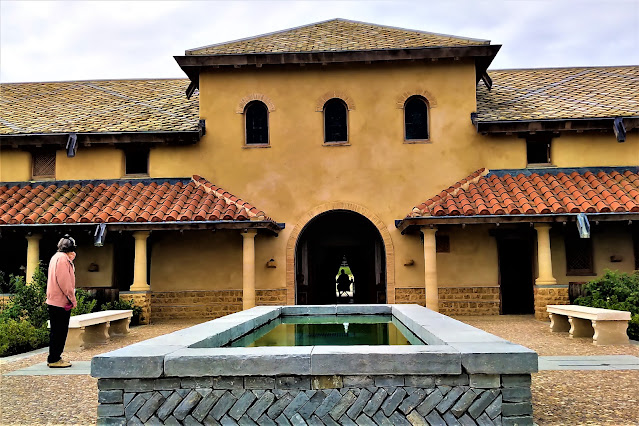Important Roman Site in Carlisle
Introduction
Yesterday, I was privileged to be a volunteer worker on the extensive Roman excavation site at Carlisle in N.W. England. For half the day I was engaged in heavy duty earth moving with second half sitting with the finds curator and recorder.
In essence the site consists of a high status, villa type complex incorporating terraces with a luxury bathhouse close by. It is likely that the Emperor, Septimus Severus commissioned the residence and/or actually resided there for a short period. Some sources speculate that the residence may have been similar in design to the Septizodium in Rome which was also associated with Severus.
9.00 am site briefing for volunteers.
Carlisle's Roman Bathhouse Project
Professional archaeologists began work in 2017 following which they discovered the remains of a monumental Roman bathhouse which has been determined to be of national importance.Location is the outer perimeter of Carlisle Cricket Club grounds.
The bathhouse facility may have belonged to the Stanwix (Petriana) fort discussed below.
The remains and objects found by archaeologists suggest the bathhouse was built around the early 3rd century AD, possibly coinciding with the granting of civitas (self governing) status to the town of Carlisle.This bathhouse is larger than any other such facility in the northern frontier zone.
Illustration of Roman bathhouse from nearby Vindolanda.
Carlisle in Roman Times
The Romans first came to Carlisle in AD 72 and built a fort opposite the current castle entrance.This was to house a cavalry regiment of 500 soldiers, In AD 122 the Emperor Hadrian implemented his scheme to build a wall across the Northern Frontier.
As part of Hadrian's frontier wall a second fort was built in the Stanwix area of Carlisle.This was the largest fort on the wall and was named Petriana or Uxelodunum. This fort was rebuilt in stone around AD130. It housed a 1000 strong cavalry regiment, the Ala Gallorum Petriana, the largest regiment on the wall.The fort was constructed (like many others) so the wall passed along the north side.It was likely built on the particular site to guard the River Eden bridgehead and watch the important western route to and from Scotland.
The town began as a military settlement with a centurion in charge of the region. In the 3rd century Emperor Septimus Severus allowed Carlisle to become a civitas -a town run by its own civilian council. It was the only settlement in the north-west of Britain to be given this status. Trade was important with goods imported from other parts of the Empire such as Germany, Italy and France.
Severus' Campaign
Septimus Severus (ruled 193-211) became Emperor after a civil war. His rival, Clodius Albinus, had removed troops from Britain leaving barbarians north of Hadrian's Wall to take advantage of the resulting weakness.Severus immediately repaired the frontier forts, reinforced the troops and invaded Scotland. He died in York before there was a lasting victory. For the rest of the Roman occupation period the pattern was one of repairs to the wall and campaigns against invaders.
The Emperor relied on the army as a base for his power and sought a military solution to the unrest caused by the Maeatae, a native tribe based near Stirling in central Scotland. Severus wished to conquer the whole island of Britain and came in person to conduct the campaign. However, he died before completing the task and his sons pursued a diplomatic solution. This policy produced peace on the frontier for nearly 100 years.
Site Images
This collection was found during my morning earth moving session. The red/ochre coloured pottery is called Samian Ware which was made on an industrial scale in France (Gaul). Such pottery is very common on high end sites such as villas. The grey coloured fragment in bottom right is probably Grey Ware which was made locally in Britain. Two animal teeth are evident the background to which is open to speculation but post-Roman squatters could be considered.
Ceramic Fragment
The pattern could have been caused by connecting the wet clay with some form of textile.
Spherical Object
This has been provisionally identified as a pestle used for grinding corn. Made from sandstone.
Probably a needle. Made from animal bone.
If there was an 'eye' at the end it may have broken off.
Peg made from bone.
May have been used in textile manufacture.
Roman Coin
Constantine?
Base of broken Samian Ware pot.
Maker's stamp has last four letters LLUM.
Broken Tile
Pronounced letter P is probably part of IMP indicating the imprimatur of the Emperor.
Excavation of Roman drain in process
This was probably spring fed and connected to the bathhouse.
Another View of the drain.
This is the area where funerary remains have been found.
Stone structure in bottom left might be the base of an elaborate memorial.
This shot illustrates the terracing on which the residence was constructed.
(Well above the prevailing flood plain!)
More Information.
Please refer previous blog posts as follows:
- Jan 3rd 2024:https://www.nigelsphotoblog.co.uk/2024/01/roman-bathhouse-at-carlisle.html
- Nov 9th 2023:https://www.nigelsphotoblog.co.uk/2023/11/roman-bathhouse-at-carlisle.html
- Feb 2nd 2023: https://www.nigelsphotoblog.co.uk/2023/02/roman-finds-at-carlisle.html
- Nov 5th 2024:https://www.nigelsphotoblog.co.uk/2024/11/impressive-find-from-carlisle-roman.html
The Tullie Museum and Art Gallery has a fine exhibition covering the Roman period on the basement floor. This facility is located opposite to entrance of Carlisle Castle.
Update December 6th 2024
This nationally important site continues to attract attention from archaeology professionals which has resulted in focus on the following publications:
It is to be hoped that this site will attract continuity of funding to facilitate completion of the excavation and ultimately evolve into a visitor attraction.















Comments
Post a Comment